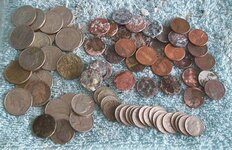bigscoop
Gold Member
- Jun 4, 2010
- 13,373
- 8,689
- Detector(s) used
- Older blue Excal with full mods, Equinox 800.
- Primary Interest:
- All Treasure Hunting
Weight of Common/Modern US Coins (grams)
Quarter – 5.6
Nickel – 5.0
Penny – 2.5
Dime – 2.2
Diameter of Common/Modern US Coins (mm)
Quarter – 24.26mm
Nickel – 21.21mm
Penny – 19.5mm
Dime – 17.91mm
Weight Per-Surface Area of Common Modern US Coins (grams)
Quarter – .2308326 per mm
Nickel – .2357378 per mm
Penny – .1282051 per mm
Dime - .1228364 per mm
Relative Sink Rate of Common/Modern US Coins by Surface Area (Densest First)
Nickel
Quarter
Penny
Dime
The old timers knew what they were talking about, the ability to detect nickels wasn’t simply a matter of its conductive similarity to gold. As can be viewed in the chart above, the ability to find nickels at depths wasn't just a means of insuring that gold would be detected, but this ability to detect nickels also provided a type of measuring stick when in the field.
Quarter – 5.6
Nickel – 5.0
Penny – 2.5
Dime – 2.2
Diameter of Common/Modern US Coins (mm)
Quarter – 24.26mm
Nickel – 21.21mm
Penny – 19.5mm
Dime – 17.91mm
Weight Per-Surface Area of Common Modern US Coins (grams)
Quarter – .2308326 per mm
Nickel – .2357378 per mm
Penny – .1282051 per mm
Dime - .1228364 per mm
Relative Sink Rate of Common/Modern US Coins by Surface Area (Densest First)
Nickel
Quarter
Penny
Dime
The old timers knew what they were talking about, the ability to detect nickels wasn’t simply a matter of its conductive similarity to gold. As can be viewed in the chart above, the ability to find nickels at depths wasn't just a means of insuring that gold would be detected, but this ability to detect nickels also provided a type of measuring stick when in the field.

Upvote
0




 )
)


